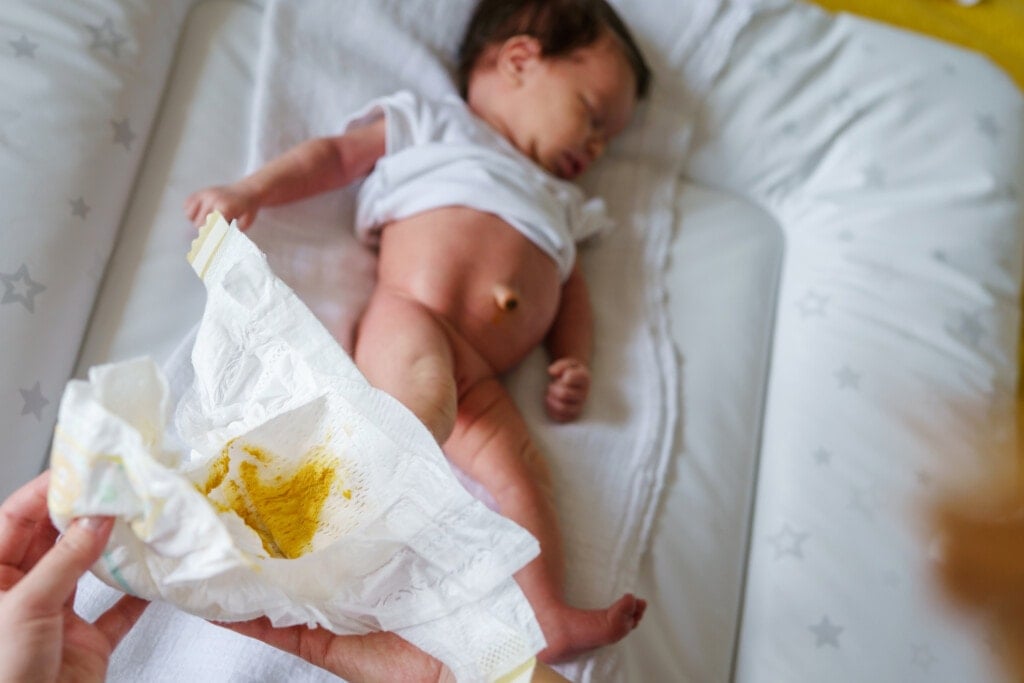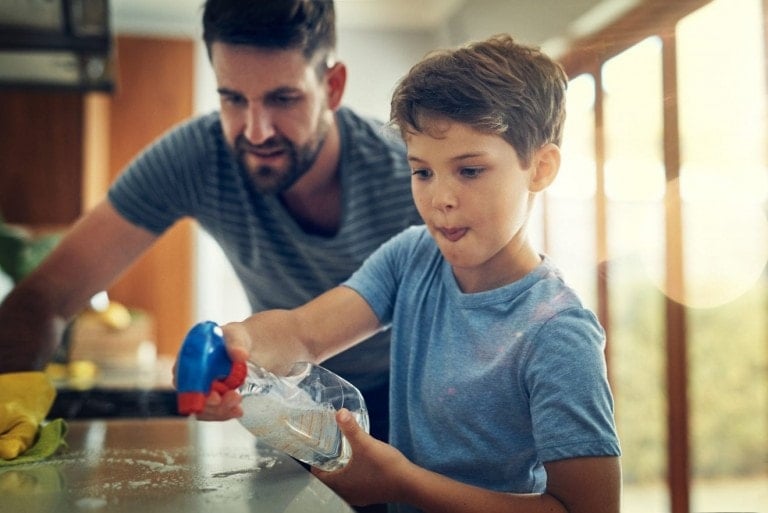There might not be any other time in your life that you’re more obsessed with poop than when you become a new parent! Okay, maybe middle school was a close second for some. But this is a very different kind of obsession. New parents spend a lot of time looking at, talking about, and cleaning up poop. That’s because babies poop an average of two to three times a day for the first year of life.1 That’s nearly 1,000 poops! So here’s the scoop on 12 types of baby poop and what they mean.
Baby Poop: What Does It Mean?
1. Meconium
This is the first poop your baby will ever have. Congrats, new parent! Meconium is a sterile, thick, tarry, black-green, odorless poop. It’s the result of everything your baby’s gastrointestinal tract accumulated in utero, including old blood, which gives it that true black color. It can occur during delivery or usually within 36 hours after. This is the only time that truly black stool is okay for your baby or, really, for anyone.
2. Breastmilk Poop
Newborn breastmilk poop is very liquidy and frequent. Sometimes newborns poop with every feed, which can be up to ten times per day! It is often very watery because it is so easily digested. It’s commonly yellow and seedy. But any shade of yellow, green, brown, or orange is normal. It can have a sweet or yeasty odor.
3. Formula Poop
This poop tends to be thicker than breastmilk poop. It’s often more green or brown and slightly darker than breastmilk poop. The consistency is similar to peanut butter. Any shade of yellow, green, brown, or orange is also normal.
4. Transitional Poop
This is something between the thick dark meconium and the softer stools from breast milk or formula. Babies don’t eat much in the first few days of life, and most lose weight during this time, which is also normal. We usually expect them to lose up to 10% of their birth weight. By days 3 to 5 of life, though, your baby should start gaining the weight back. The poop before they’re eating well and gaining weight is a transition from meconium to the traditional breastmilk or formula poops.
5. Solids
Once your baby starts eating solid food, not just drinking breast milk or formula, the stool drastically changes. It becomes smellier and thicker, trending more towards the poop of an adult. The color also changes and often reflects the color of the foods they ingest. You can even see pieces of undigested food in the poop; this usually freaks out new parents but is normal.
6. Diarrhea
Parents often have difficulty defining diarrhea for a baby, especially in the early days when every poop looks like what you would call diarrhea for an adult. The key indicator for diarrhea is a change in your baby’s regular stool pattern. So if your baby goes more frequently than usual, or the poop is more liquidy than normal, that’s considered diarrhea. The problem when you have a newborn is that you don’t know what “normal” is yet!
Diarrhea can be from an infection, food intolerance, medication side effect, or simply from swallowing extra saliva or snotty mucus if your baby is teething or has a cold. If you’re concerned your baby might have diarrhea, especially while you’re figuring out what “normal is,” you should check with the baby’s doctor.
7. Constipation
Constipation is when your baby has hard stools. Poop that looks like small rabbit-like pellets, hard logs, or marbles usually means constipation. Constipation is not defined by how your baby looks or sounds when pooping or even the frequency of the poops. This is a very common mistake new parents make.
If your baby grunts, squirms, or turns red when pooping, that does not necessarily mean your baby is constipated. Pooping is a very complex series of events that one has to get used to! It requires contracting specific muscles while relaxing others. And your baby has to do it all while lying on their back! Frequency is not an indicator of constipation, either. Some breastfed babies hang onto all the nutrients they need and can go for many days without pooping. So use the consistency of the poop to determine if your baby is constipated or not. Constipation usually means your baby needs more liquid or fiber in the diet, but the specifics vary with your baby’s age, so check with the doctor to see what your baby might need.
8. Mustardy Poop
Whether it’s reminiscent of Grey Poupon, a typical chef’s mustard like Maille with the grainy, seedy texture, or the classic French’s yellow mustard, any mustardy poop is common for breastfed babies. If this is the stage you’re in, it’s understandable that you’ll be putting ketchup on your hot dog for a while!
9. Green Poop
Green poop is normal! If your baby is happy and growing fine, it’s usually nothing to worry about. Dark green poop can come from pigment in foods like spinach and other vegetables. Or it can happen when taking iron supplements. Bright green poop can mean that the food passed quickly through the intestines for some reason. Or, if nursing, bright green poop can indicate that your baby received more thin foremilk than fatty hindmilk. If your baby is doing fine, though, it’s usually nothing to blink an eye at. But if your baby isn’t growing well or is otherwise not feeling well, it’s something to check in with the doctor about. In that case, it can indicate infection or another issue.
If your baby’s poop is consistently green with mucus, looking like you blew your nose in your baby’s diaper, you should call the doctor. That could indicate there’s a milk protein intolerance or some other problem.
One other classic cause of bright green poop is food dye. Not just green food dye, though. Remember your color wheel! A birthday cake with blue and yellow frosting can create the scariest, brightest green poop you’ve ever seen!
10. Red Poop
If your baby has bright red poop, you should definitely check with the doctor. This is most likely blood and can mean one of many different things. It can simply be an anal fissure, which is a small tear in the skin around the butt hole, which can cause streaks of blood to appear in usually very hard poop. It can be blood from your nipple if you’re breastfeeding and have bleeding, cracked nipples. Blood in the stool can also be from a bad, bleeding diaper rash. Or it can be a sign of milk protein intolerance. However, red stool can sometimes signify something much more serious, like an infection or intussusception. So if your baby ever has a fever or pain with the red poop, you should call the doctor immediately. Infection can be from a virus, bacteria, or parasite. Intussusception is a medical emergency where the intestines telescopes back into itself. This is accompanied by severe pain and sometimes what is called “red currant jelly” stool.
11. Black Poop
This is why paying attention to that first meconium poop is good. Because that’s a true black stool, not just dark. It usually never happens again. But if you do ever see another true black poop, you should save it and call your baby’s doctor. It could mean there’s blood in the gastrointestinal tract.
12. White Poop
Truly white stool with no color is very rare and not subtle, but you should call the doctor if you see it because it could indicate a liver problem.
So there you have it, the 12 most common types of baby poop and what they might mean. Once your baby starts talking, it will become a little easier to figure out all these mysteries. For now, though, use the clues you have. You’re doing great!






























